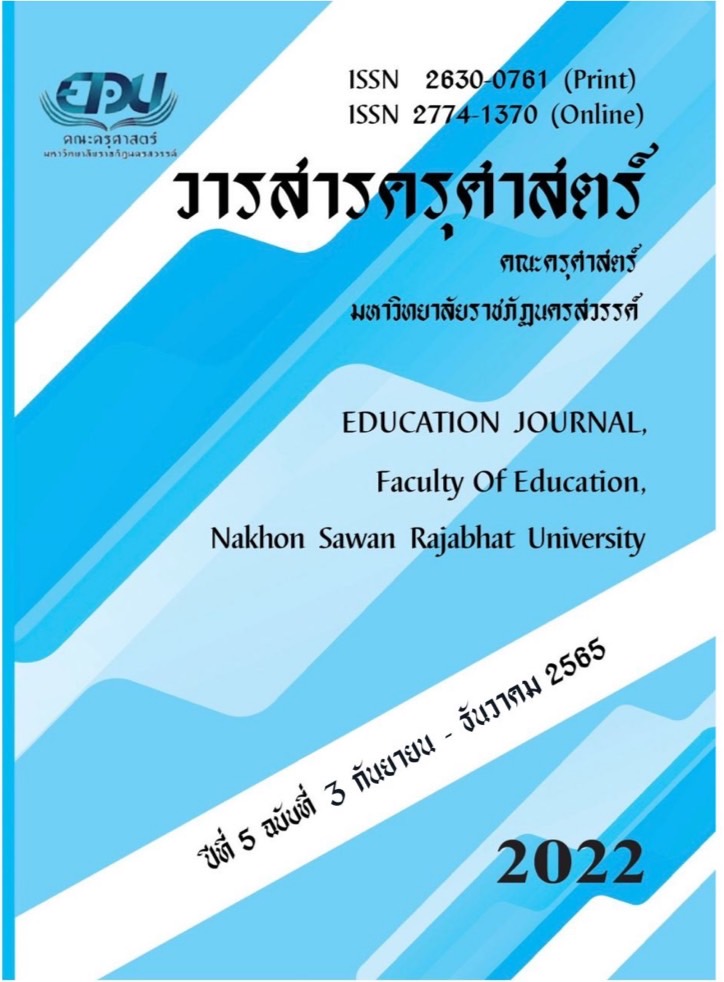A Study of The Effects of Mathematics Learning Activities on Polynomial by Constructivism Theory Approach Cooperated with Student Teams Achievement Divisions Technique (STAD) for Secondary School Grade 8
Main Article Content
Abstract
This research aimed to study 1) to study the effects of mathematics learning activities on polynomial for secondary school grade 8 with the criterion efficiency of E1/E2. 2) to compare the academic achievement in mathematics on the subject under study prior to and after the study, 3) to examines the student satisfaction with the learning activities on polynomial by constructivism theory approach cooperated with student teams achievement divisions technique (STAD) for secondary school grade 8. The sample consisted of thirty-five grade 8 students in the first semester of the academic year 2019 in one classroom at the demonstration school of Ramkhamhaeng University (secondary level) using the technique of cluster random sampling. The research instruments consisted of lesson plans, an academic achievement test, and a form to measure the student satisfaction with the learning activities. The statistics used in data analysis were mean, percentage, and standard deviation. The technique of t-test dependent was used to test the hypothesis. The research was as follows:
1) The mathematics learning activities developed exhibited an efficiency of 83.16/82.10 in accordance with the set criterion efficiency of E1/E2, 2) The academic achievement in mathematics on polynomial by constructivism theory approach cooperated with student teams achievement divisions technique (STAD) for secondary school grade 8 was higher after the study than prior to the study at the statistically significant level of .05. 3) The level of student satisfaction with the learning activities on polynomial by constructivism theory approach cooperated with student teams achievement divisions technique (STAD) for secondary school grade 8 overall was at a high level with the mean being 4.19.
Downloads
Article Details

This work is licensed under a Creative Commons Attribution-NonCommercial-NoDerivatives 4.0 International License.
References
กระทรวงศึกษาธิการ. (2553). แนวทางการจัดกิจกรรมพัฒนาผู้เรียนตามหลักสูตรแกนกลางการศึกษาขั้นพื้นฐาน พุทธศักราช 2551. (พิมพ์ครั้งที่ 2). กรุงเทพฯ: โรงพิมพ์ชุมนุมสหกรณ์การเกษตรแห่งประเทศไทย จํากัด.
________. (2560). ตัวชี้วัดและสาระการเรียนรู้แกนกลาง กลุ่มสาระการเรียนรู้คณิตศาสตร์ (ฉบับปรับปรุง พ.ศ. 2560) ตามหลักสูตรแกนกลางการศึกษาขั้นพื้นฐาน พุทธศักราช 2551. กรุงเทพฯ: โรงพิมพ์ชุมนุมสหกรณ์การเกษตรแห่งประเทศไทย จํากัด.
ทิศนา แขมมณี. (2545). รูปแบบการเรียนการสอนทางเลือกที่หลากหลาย. กรุงเทพฯ: ด่านสุธาการพิมพ์.
ชูศรี วงศ์รัตนะ. (2553). เทคนิคการเลือกใช้สถิติเพื่อการวิจัย. (พิมพ์ครั้งที่ 12). นนทบุรี: ไทเนรมิตกิจ อินเตอร์ โปรเกรสซิฟ.
นพพร แหยมแสง, และ อุไร ซิรัมย์. (2561). พฤติกรรมการสอนคณิตศาสตร์ 1. (พิมพ์ครั้งที่ 3). กรุงเทพฯ: สำนักพิมพ์มหาวิทยาลัยรามคำแหง.
เพ็ญประภา อุดมฤทธิ์. (2558). การศึกษาผลสัมฤทธิ์ทางการเรียนคณิตศาสตร์ โดยใช้ชุดการเรียนการสอนเรื่อง สมการกำลังสองของนักเรียน ชั้นมัธยมศึกษาปีที่ 3 ตามแนวคิดคอนสตรัคติวิสต์ร่วมกับวิธีการเรียนแบบร่วมมือเทคนิค STAD. วิทยานิพนธ์ศึกษาศาสตรมหาบัณฑิต (คณิตศาสตรศึกษา). กรุงเทพฯ: มหาวิทยาลัยรามคำแหง.
มลฤดี สิงห์นุกูล. (2555). การศึกษาผลสัมฤทธิ์และความพึงพอใจในการเรียน เรื่อง สมการเชิงเส้นตัวแปรเดียว ชั้นมัธยมศึกษาปีที่ 1 ตามแนวทฤษฎีการสร้างองค์ความรู้ด้วยตนเองร่วมกับวิธีเรียนแบบร่วมมือเทคนิค STAD. วิทยานิพนธ์ศึกษาศาสตรมหาบัณฑิต (คณิตศาสตรศึกษา). มหาวิทยาลัยรามคำแหง.
วัฒนาพร ระงับทุกข์. (2542). แผนการสอนที่เน้นผู้เรียนเป็นศูนย์กลาง. กรุงเทพฯ: สำนักพิมพ์แห่งจุฬาลงกรณ์มหาวิทยาลัย.
วัลลดา เกตุจันทร์. (2558). การศึกษาผลสัมฤทธิ์ทางการเรียนวิชาคณิตศาสตร์เรื่อง อัตราส่วนตรีโกณมิติ ของนักเรียนชั้นมัธยมศึกษาปีที่ 5 ตามแนวคิดทฤษฎีคอนสตรัคติวิสต์ร่วมกับวิธีเรียนแบบร่วมมือด้วยเทคนิค STAD. วิทยานิพนธ์ศึกษาศาสตรมหาบัณฑิต (คณิตศาสตรศึกษา). มหาวิทยาลัยรามคำแหง.
สถาบันทดสอบทางการศึกษาแห่งชาติ (องค์การมหาชน). (2562). รายงานผลการทดสอบทางการศึกษาระดับชาติขั้นพื้นฐาน (O-NET) ชั้นมัธยมศึกษาปีที่ 3 ปีการศึกษา 2561. สืบค้นเมื่อ 2 มกราคม 2562, จาก http://www.newonetresult.niets.or.th /AnnouncementWeb/PDF/SummaryONETM3_2561.pdf.
สถาบันส่งเสริมการสอนวิทยาศาสตร์และเทคโนโลยี. (2560). รายงานผลการวิจัยโครงการ TIMSS 2015. สืบค้นเมื่อ 12 มกราคม 2562, จาก https://drive.google.com/file/d/19xvsLP_bLN8q6wkzX9hVIvV_TS4hyuGa/view.
สิริพร ทิพย์คง. (2545). หลักสูตรและการสอนคณิตศาสตร์. กรุงเทพฯ: สถาบันพัฒนาคุณภาพวิชาการ.
สุวิทย์ มูลคำ. (2548). กลยุทธ์การสอนคิดเชิงกลยุทธ์. (พิมพ์ครั้งที่ 2). กรุงเทพฯ: โรงพิมพ์ภาพพิมพ์.
สุวิทย์ มูลคำ, และอรทัย มูลคำ. (2550). วิธีการจัดการเรียนรู้. (พิมพ์ครั้งที่ 6). กรุงเทพฯ: โรงพิมพ์ภาพพิมพ์.
อัมพร ม้าคะนอง. (2546). การสอนและการเรียนรู้. กรุงเทพฯ: โรงพิมพ์แห่งจุฬาลงกรณ์มหาวิทยาลัย.
Eggen, P., & Kauchak, D. (1994). Educational psychology: Classroom connections. (2nd ed.). New York: Maxwell Macmillan.
Glasersfeld, V. E. (1989). Constructivist in education in the international encyclopedia of education: Research and studies. New York: Progamon.
Good, C. V. (Ed.). (1973). Dictionary of education. New York: McGraw-Hill.
Martin, R. E., Sexton, C., Wagner, K., & Gerlovich, J. (1994). Teaching science for all children. Boston: Allyn and Bacon.
Shelly, M. W. (1975). Responding to social change. Stroudsburg, PA: Dowden Hutchision & Press.
Slavin, R. E. (1995). Cooperative learning. (2nd ed.). Boston: Allyn and Bacon.
Wolman, B. B. (1973). Dictionary of Behavioral Science. London: Litton Educational.


